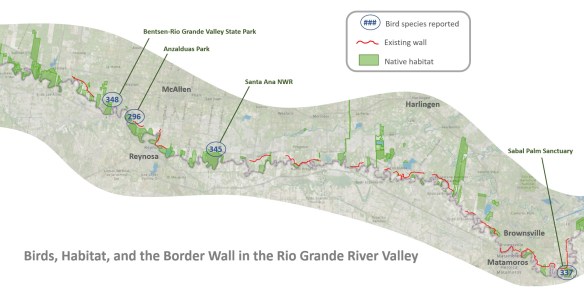Of the top 20 birding sites in the entire United States, based on the number of species reported on eBird, six of them are in south Texas. Two of them, Bentsen-Rio Grande Valley State Park and Santa Ana National Wildlife Refuge, are threatened by Trump’s proposed wall.
CLICK TO ENLARGE
The map above, taken from an excellent article illustrating all of the natural resources at risk from California to Texas, includes the bird totals for the eBird hotspots associated with the at-risk parks and wildlife refuges. The wall is often constructed hundreds of yards north of the actual border (the Rio Grande River). It typically includes a swath of cleared land on each side of it. At Bentsen and Santa Ana, the wall threatens to destroy critical remaining habitat and strand the parks in “no-man’s land”, preventing public access. Dozens of articles have been written regarding the impacts to everything from butterflies to ocelots.
Sabal Palm is unique, in that the natural area is south of the wall. Visitors pass thru the wall in order to visit the park. However, there is no guarantee this arrangement will be made at other sites. Should public access be denied at Bentsen, the park could revert back to the Bentsen family per a historical agreement. The national wildlife refuges are especially at risk. As they are already federal properties, the Administration doesn’t have to deal with acquiring private property. Thus, they are the easiest places to build.



